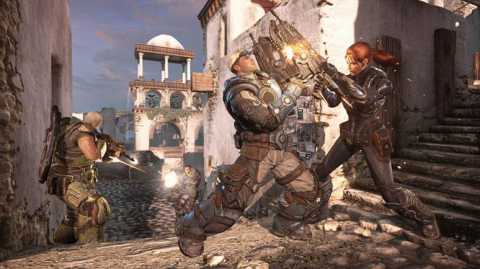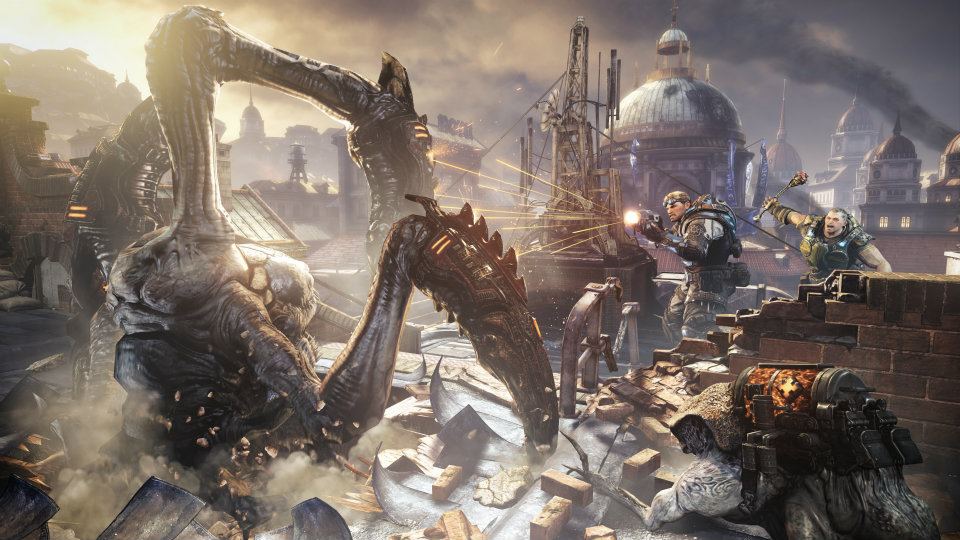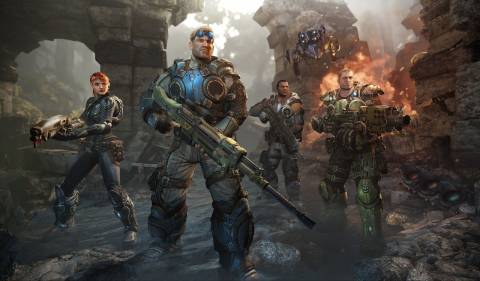
Gears of War 3 provided a relatively satisfying conclusion to the trilogy, wrapping up the events well and giving Marcus Fenix and his crew a much-needed chance to sit down. So it makes sense that another Gears of War game would be set as a prequel. Rather than taking the obvious route and showing you why Fenix needed to be broken out of jail to open the first game, the focus is put on the side characters, Baird and Cole. Don't take that to mean that Gears of War: Judgment has a deep, engaging story that makes you look upon the whole franchise in a brand-new way or anything, but there's just enough exposition there to keep things moving and just enough of a gameplay tweak to make you wish they had made these changes two games ago. It's a fun but feature-light shooter for people who already enjoy the basic style of Gears of War. Nothing more, nothing less.
The bulk of the story is told in flashback, as the four soldiers of Kilo Squad find themselves as defendants in a hastily-assembled trial. Their testimony runs throughout the game--they tell the story, you run from point to point, chainsawing and shooting Locust enemies all the while. There are no surprises along the way, either. Kilo Squad sets out to take down a big bad guy in the area and, by the end of the game, they'll have completed their task. You'll also unlock a second campaign called Aftermath, which is set during the events of Gears of War 3. In Aftermath, you'll take Baird and Cole back into an area from the Judgment campaign as they search for a boat to help with the final assault on Azura. Throughout both campaigns, the characters seem a little subdued when compared to the proper Gears trilogy. There are fewer "woo!" moments out of Cole and less machine fixing and complaining out of Baird.
That Aftermath campaign is missing the thing that actually makes Judgment cool in the first place. At the start of every section, you'll find a Gears of War logo glowing on a wall. If you run up to it and hit X, you'll be given the option to "declassify" some additional details. These act as modifiers for the gameplay that force you to play Gears of War in different ways. Sometimes you'll have to start a section with very little ammo. Other times you'll be forced to use less-than-ideal weapons for the entire section. Sometimes you'll get time limits, and sometimes you'll encounter dust or gas that makes it hard to see and aim throughout the entire area. It keeps you on your toes and gives you a reason to change up your style and stop chainsawing your way through everything that gets in your way. Each section also has a set of three stars to earn, and enabling the declassified option makes it easier to earn all three of those stars. The tradeoff is that the entire game is broken up into very tight, defined sections, which makes the whole thing feel a little artificial. You're practically given a Left 4 Dead-style safe room between every single combat section, packed with guns, ammo, and the declassification icon. It gives the game a herky-jerky feel that can be a little off-putting.

Most of the enemies are guys that you've seen before, from bloodmounts to lambent versions of various creatures, and you'll fight them with the same basic arsenal. There are a few new weapons, like the Marksa, a semi-automatic rifle with a good scope that makes for a lighter, friendlier gun in medium-range sniping situations. The biggest gameplay change is a control change that makes weapon-switching more like Halo or Call of Duty. Instead of using the D-pad to switch between four different weapons, you can now hold two, and tapping the Y button swaps between them. Grenades are now dedicated to the left bumper, rather than being something you have to select before you can use. This change may come down to personal preference, but playing Gears this way makes me wish it was like this all along. Grenades become a lot more useful when you can just toss one out at will instead of having to stop shooting just to switch over to your grenades. It's a nice change that some people will probably hate.
The multiplayer end of Gears Judgment offers a few modes, with the two new ideas based around the same concept. OverRun pits attacking Locust players against defending humans, like a melding of the co-op-only Beast and Horde modes of the past into one competitive mode. It's a fine mode that makes you wonder why it took the developers this long to get here, since all the pieces for this were in place for Gears 3. Survival mode replaces Horde mode, and it's little more than a single-team, co-op-only version of OverRun, with the AI taking up the Locust faction. Both modes are class-based on both sides of the action, so humans can choose a Soldier role, which lets them dispense ammo to teammates, a Medic role that can toss healing grenades, and two others. Locust players use a class-based system similar to Beast mode in Gears 3, with personal points unlocking the ability to spawn as more extreme enemies. OverRun is cool... but Survival isn't as good as Horde mode was in the last game.

In addition to those, you can play the campaigns cooperatively or play Deathmatch, Team Deathmatch, or Domination games. The game is still packed with ribbons and medals to earn as you play, and as you level up your character you'll earn prize boxes that randomly give you character or weapon skins. Like Gears 3, the game is also packed full of purchasable skins, and these are marked in such a way that makes it look like you'll never be able to unlock a buyable skin via the game's prize boxes. Also on the microtransaction front is the ability to straight-up buy double XP bonuses that last for a set number of matches. What, no soda or chip company wanted to kick down and print codes on their packages? Players that purchase the Season Pass DLC pre-order get access to a "VIP" matchmaking option that includes all of that DLC and generates more XP than the standard matchmaking option. It's... a bit much, especially because the game only ships with four maps for OverRun/Survival and four for TDM and the other competitive modes. The multiplayer side of Judgment just feels thin.
Despite my feelings that Baird is the most extraneous character in the Gears universe and a general feeling after Gears 3 that I was probably done with this franchise, Judgment is still a good time. It doesn't let its story get in the way of its action, and the declassified modifiers had me playing Gears in ways that I normally wouldn't, making for a more interesting challenge than the typical difficulty settings offer. But the lack of maps just sucks every last bit of life out of the multiplayer, regardless of its new modes.